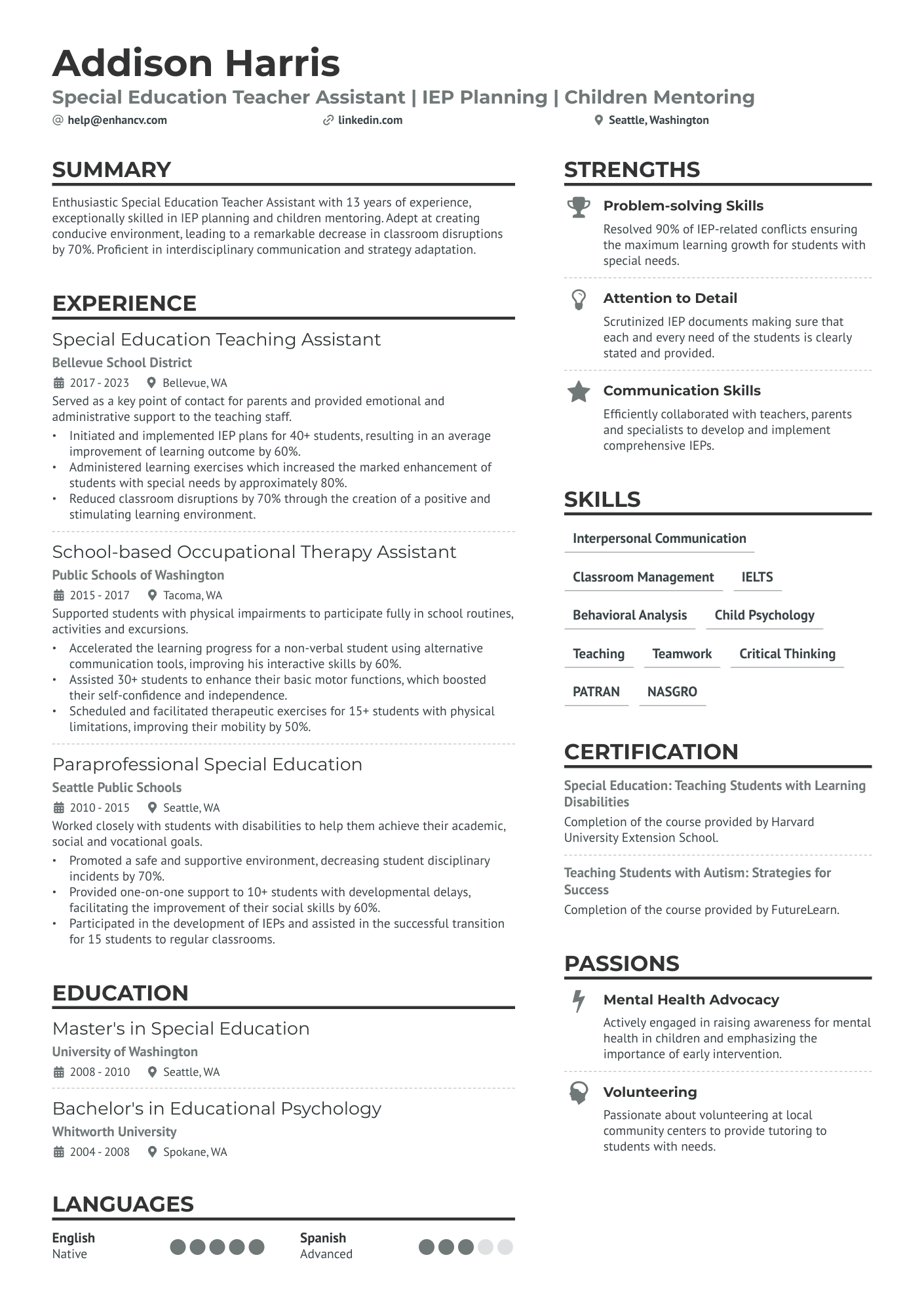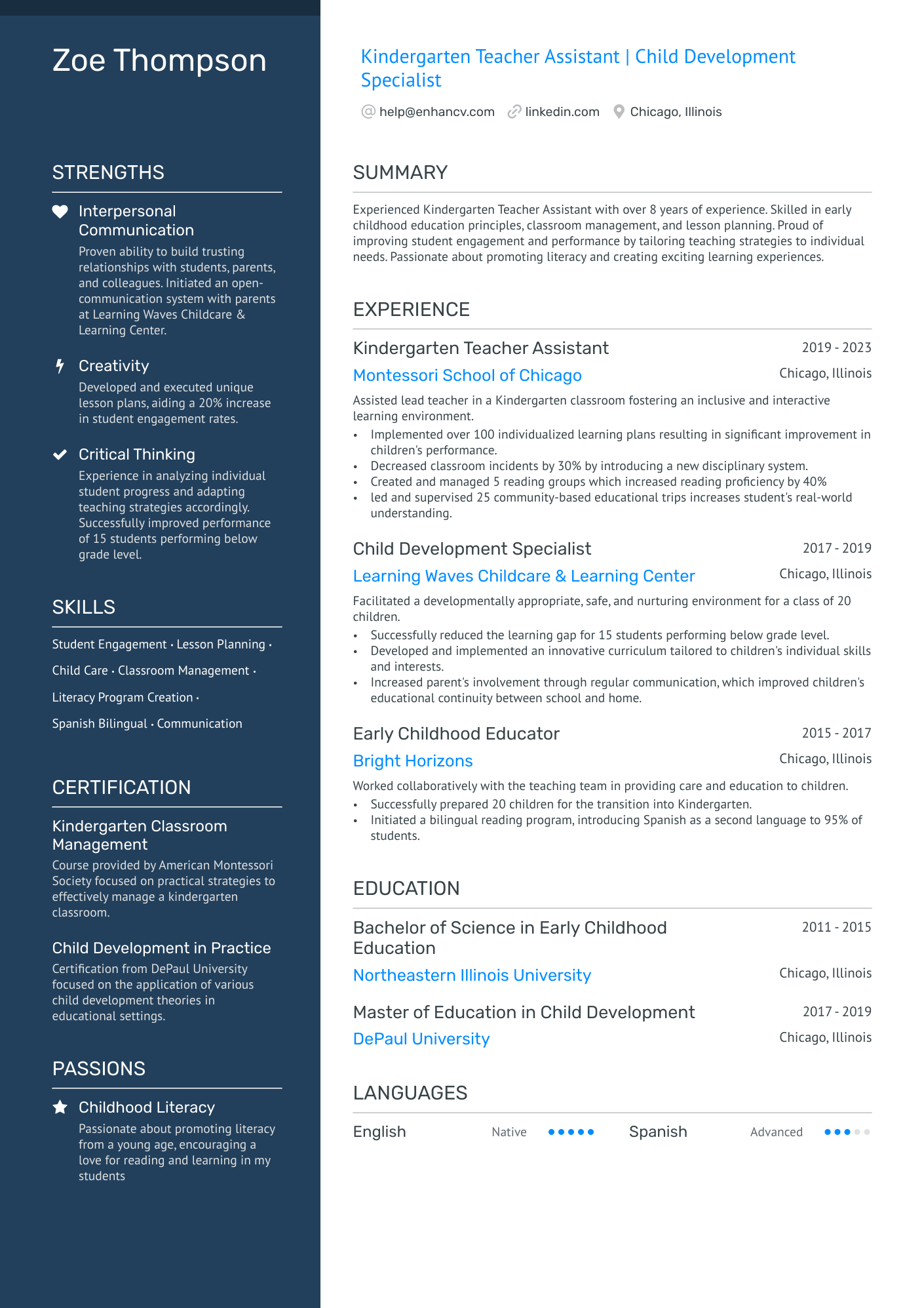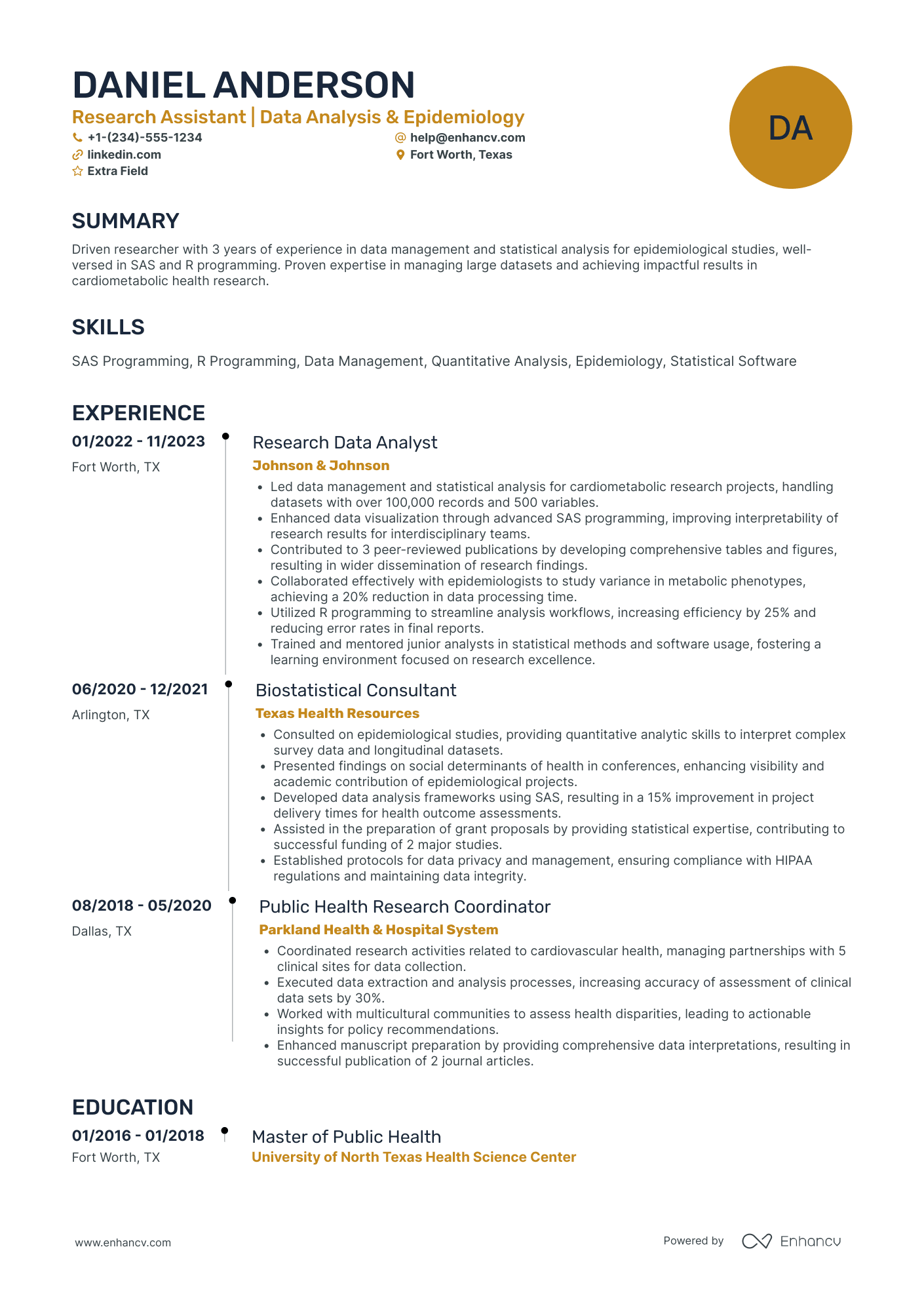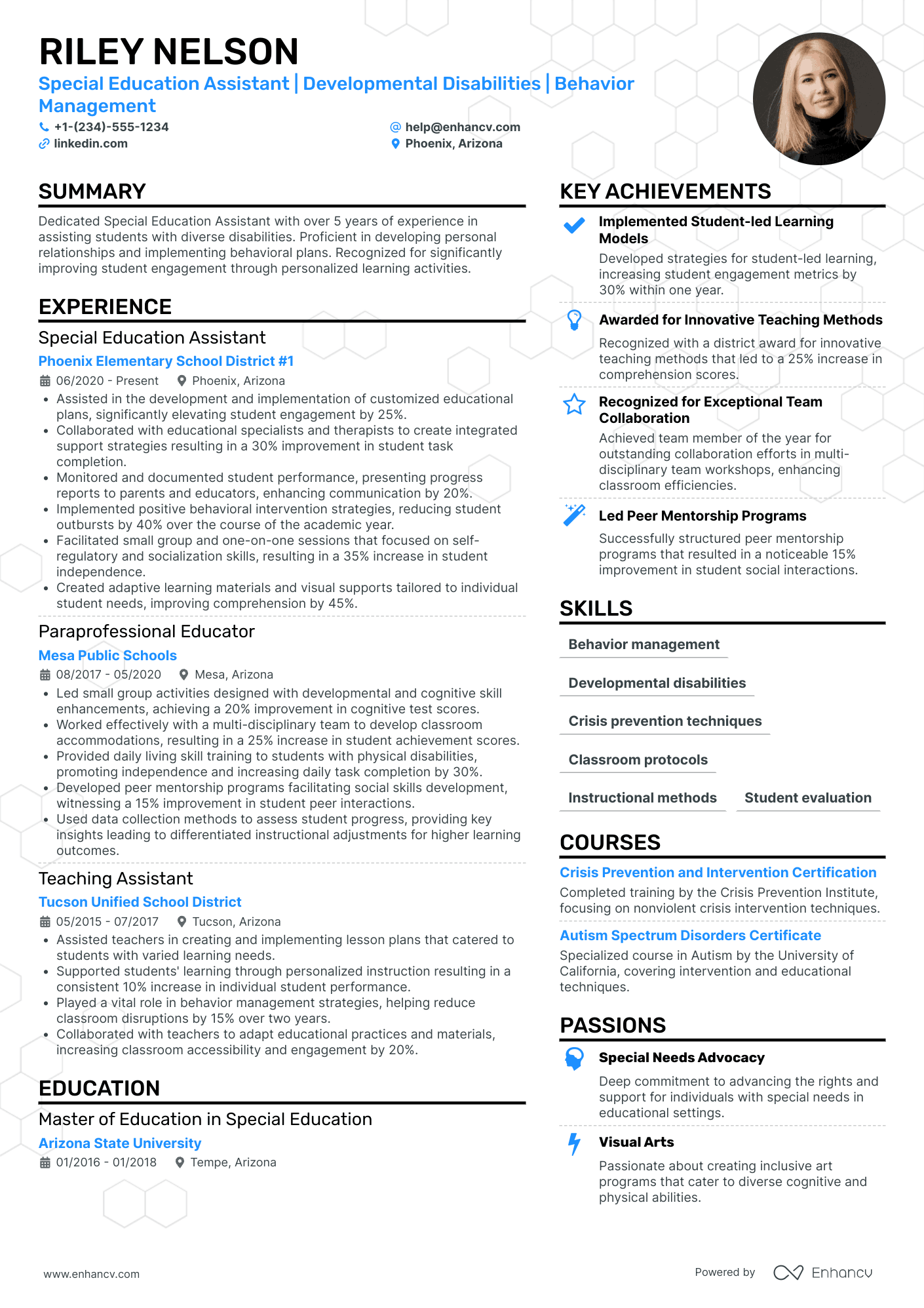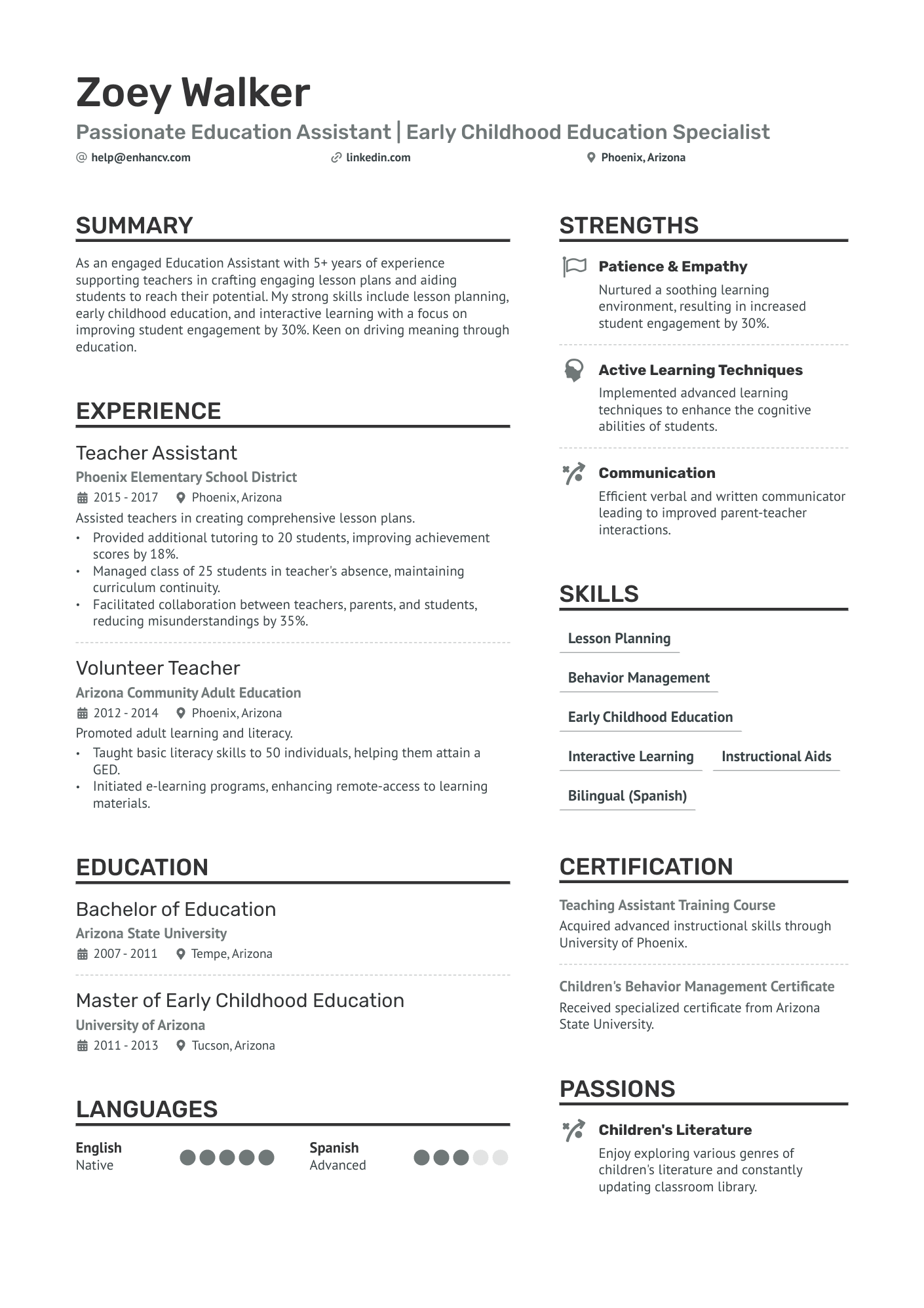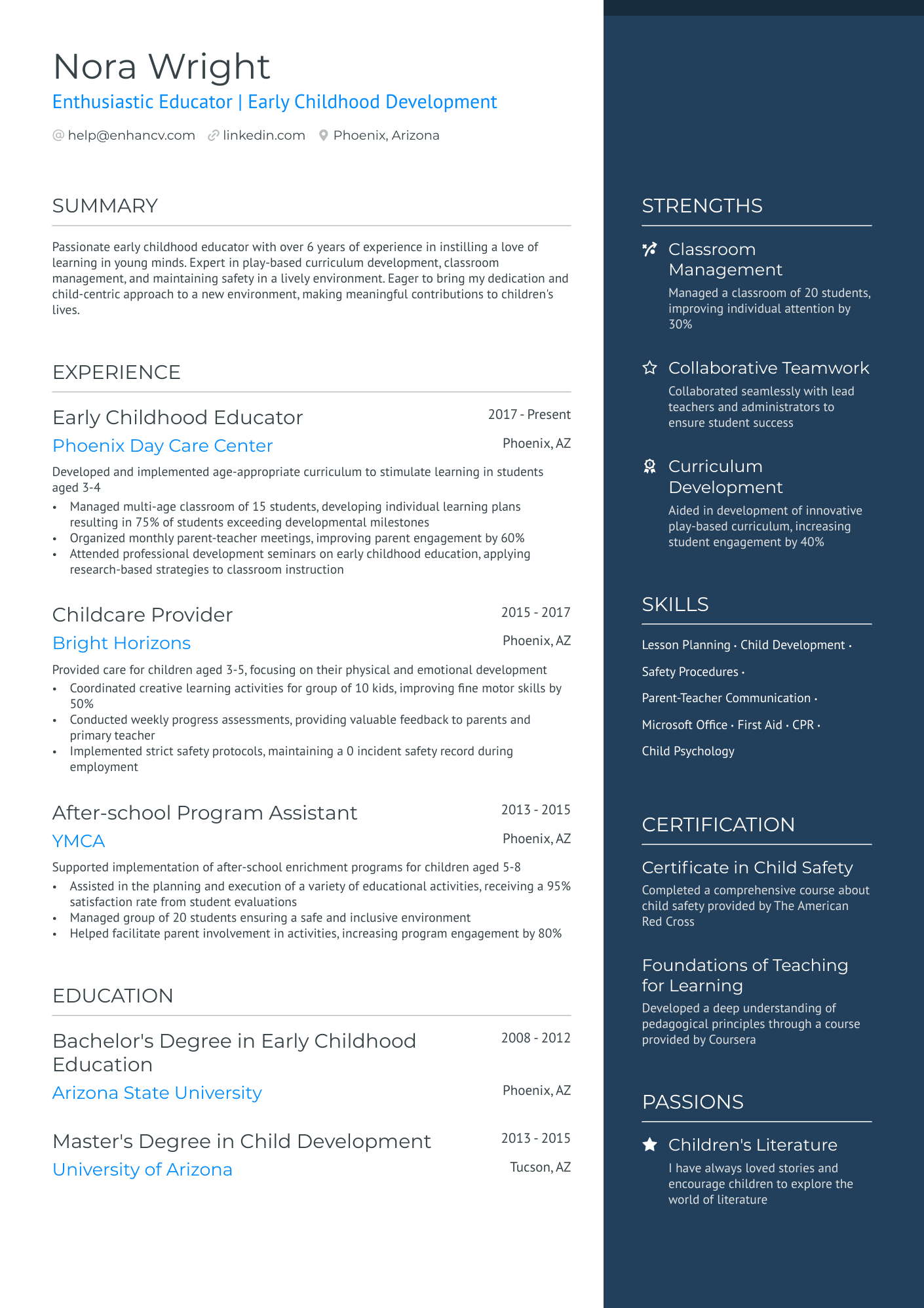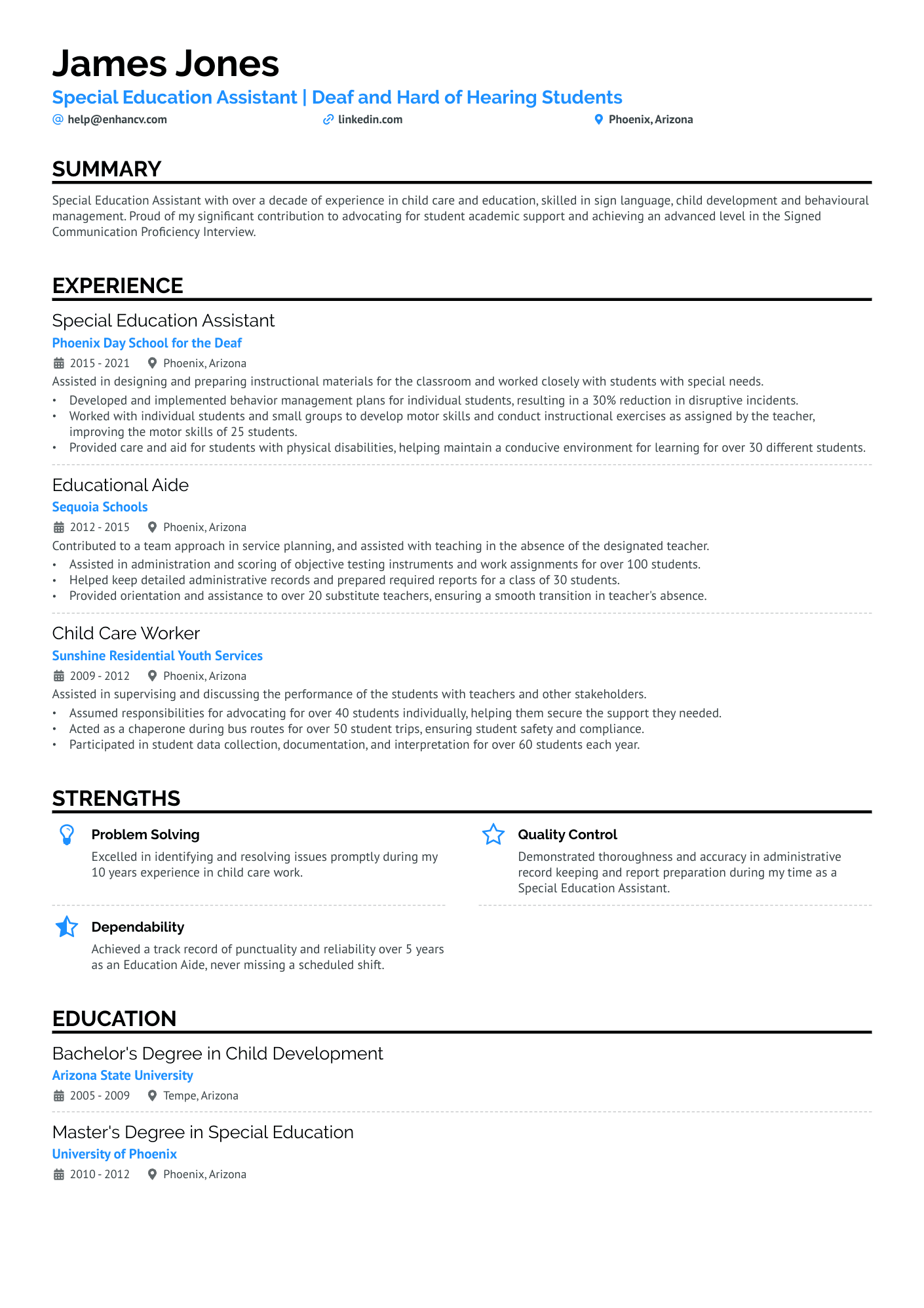Talented teacher assistants stand out like professional basketball players.
Why?
Not only are they masters of their craft. But they’re also all about teamwork and supporting their MVP - the main teacher.
Many students felt disenfranchised by the school system after the sudden shift to online classrooms during the pandemic.
And ever since then soft skills have gradually become the most sought-after skills when it comes to assistant teachers.
But do you know how to display your social skills prowess on your resume?
Follow our thorough guide to:
- Learn what to put on your teacher assistant resume, depending on who’s reviewing your application
- Reference a real resume example and sample sections while writing your own
- Master building a resume, even if you’re just fresh out of college
If you’re looking for other teaching-related resume examples here are our other resumes examples:
- Teacher Resume Examples
- Math Teacher Resume Examples
- Substitute Teacher Resume Examples
- First Grade Teacher Resume Examples
- Transitioning Teacher Resume Examples
- New Teacher Resume Examples
Teacher assistant resume example
The best way to get the hang of resume writing is to examine a good example first:
The above teacher assistant resume works for a few reasons:
- Highlighting Relevant Experience: Emphasizing classroom experience and the number of students assisted can provide a clear understanding of hands-on experience. For instance, "Skilled and motivated teacher assistant with 6 years of classroom experience. Helped 200+ students excel..."
- Specific Achievements: Mentioning specific recognitions or impacts, such as "Honored for commitment and support in 2020" or "Increased students average grades by 2 points", can showcase tangible accomplishments in the role.
- Language Proficiency: For teaching roles, showcasing language proficiency can be advantageous, especially if the role involves teaching a foreign language. In this resume, the mention of "master of English and Spanish languages" stands out.
- Relevant Certifications: Highlighting specific certifications related to the role can bolster qualifications. In this case, the "Teaching English as a Foreign Language (TEFL)" certification is a valuable addition for a teacher assistant role.
Choosing a foolproof layout for your teacher assistant resume
Even if you have lots of experience to share, a bad resume format can ruin your chances from the outset.
To avoid getting filtered out by the Applicant Tracking System (ATS), here are a few best practices to keep in mind:
- If you’re an experienced TA, the reverse-chronological resume format is your best option. It’s a recruiters’ favorite and it best displays your expertise.
- A link to a portfolio with your work or a publication you’ve authored in the resume header will always make you stand out.
- Which section you focus on most will depend on the type of TA job you’re applying for. If you’re a tenured TA, focus on the experience section and the summary.
- It’s okay to make a two-page resume, provided you have a long work history. But it’s best to keep it short and fit the most important bits of information within the first page.
- Finally, unless there are any special filetype requirements, save and send your teaching assistant resume as a PDF file. It will preserve the design and formatting of the document.
The must-have sections on a teacher assistant resume:
- A resume header at the top to outline your basic information and link to your portfolio
- A resume objective (or summary) to highlight your achievements and career mission
- A detailed experience section to showcase different aspects of your expertise
- A skills section to describe other relevant and transferable abilities you have to offer
- A certificates and education segment to provide an overview of your credentials
What recruiters want to see on your resume:
- If you’re applying for a preschool teacher assistant role, emphasize any prior work with children. Such as babysitting or caring for children with disabilities.
- Aiming to become an undergraduate or a graduate teacher assistant? Then feature some of your publications and awards. Especially if they’re within the same academic field.
- Some specialized and private schools demand more formal training from their teacher assistants. So, read the job ad carefully and add any relevant training you’ve undergone.
- Demonstrate you have experience with blended and e-learning classrooms.
- Principals and main teachers are searching for team players. Draw attention to cases where you’ve helped with lesson planning or test grading.
- Administrative work isn’t all teacher assistants do. Teachers must be able to rely on you during class. Share how you’ve managed to keep class focused while dealing with unruly students.
- Depending on the school, you may have to deal with diverse classes where multiple languages are spoken. In this case, list any languages you’re proficient in.
How to grab principal’s attention with your teacher assistant resume experience
The experience section makes up the larger part of your resume, regardless of how long your work history is.
If you’d had the opportunity to be an instructional assistant at various different schools, be selective about the information you share.
If the job description requires the perfect candidate to be more involved in classroom activities, point to past positions where you’ve actively helped handle the teaching process.
As we’ve mentioned in the beginning, the educational landscape changes rapidly. So, keeping your resume relevant is vital.
Listing a past position from a decade ago won’t do your application much good.
Also, don’t add more than 3 bullets in each experience entry, but make sure you show how the scope of your abilities has expanded over the years.
If the length of your work history falls somewhere between the 5-7 year mark, you can add more bullet points. But limit them to no more than 1-2 for each entry.
Don’t forget to talk about both the in-class and administrative side of your role.
But if you have no more than 3 years of professional experience, emphasize other work with kids you’ve done.
For example, volunteering as a face painter at a festival or working as a children's entertainer.
Pro Tip
One way to stand out among other candidates is to specify the teacher-to-student ratio of your classes. This will put your achievements into context without having to reference the size of your classes in each bullet point.
All things considered, how impactful do you think is the following experience section sample?
- •Increased the student enrollment rate.
- •Improved student engagement.
- •Facilitated a lot of parent-teacher meetings.
- •Helped students with experiments.
It doesn’t pack a punch, does it?
Liana has made quite a few mistakes while writing this particular entry:
- While she has used the description field to outline her duties, she hasn’t managed to stray away from the to-do list style of writing in the bullet points.
- Consequently, Liana has missed the opportunity to share some of her career milestones. Yes, the applicant states she was responsible for the increase in student enrollment, but no actual proof is provided.
- The last bullet point is rather ambiguous and it can potentially lead to a misunderstanding. Liana hasn’t specified the type of experiments in question or why they are being conducted.
- None of the listed achievements have been quantified. This means that principals will have to take Liana’s word for her claims, instead of referencing data.
We helped Liana rewrite the entry. The upgraded version reads as follows:
- •Increased the student enrollment rate by 9% by aiding teachers with student feedback analysis and integrating the insights into the curriculum.
- •Improved student engagement by during lessons by counseling and working one-on-one with 5 students with behavioral issues.
- •Facilitated more than 30 parent-teacher meetings to accommodate busy parents who couldn't participate within the initially alloted time, as well as alleviate the head teacher's workload.
- •Founded the Young Scientist Club for students who are interested in applied science, where they can conduct safe and age-appropriate scientific experiments.
How to quantify impact on your resume
Now that you’ve seen how important data is, let’s talk about which aspects of your job can be tied to numbers.
Before you start building your resume, consider the following questions:
- How have you added value to your workplace in the past? Is your impact limited to the classroom or you’re involved in other areas of school life, too?
- In what ways have you supported the main teacher? Did you help reduce their workload? How about being proactive by helping a struggling student improve their grades?
- Show how you’ve supported the main teacher while at work. How did you ease their struggles? How about being proactive and providing ideas and suggestions?
- How do you ensure the students are engaged with the lesson? How do you ensure students don’t fall back in class?
- Were there any ongoing issues you’ve managed to solve? How did you tackle the challenge and what happened afterwards? Flaunt your problem-solving skills.
- How many students did you have to oversee on average? What was their age range? Was it a diverse classroom? Were there any special needs students?
- How do you foster a sense of community in your students?
- What is your overall impact on your students’ graduation rate?
How to craft a teacher assistant resume with no experience
For anyone switching careers or just graduating from college, building a solid experience section is hard. But there are ways to get noticed:
- Reference any children related work you’ve done or any experience you have with the education industry.
- Highlight relevant majors and minors when listing your degree. Move the education and certificates section closer to the top of your TA resume.
- Opt for the functional resume format, if you’re a college grad. This layout will accentuate your skills by bringing them to the forefront.
- Use the hybrid resume format, if you’re changing your career path. The layout allows you to give a balanced overview of your abilities and any relevant experience you have.
Listing your hard and soft skills on your resume
Speaking of balance, show principals you’re a well-rounded paraprofessional. Shine the spotlight on both types of your teaching assistant skills:
- Hard skills: Including these near the top of your resume will help principals get to understand your tech background much faster.
- Soft skills: Demonstrate your work ethic and approach to education by discussing your social talents.
Once you’ve finished writing the experience section of your resume, review the bullet points one more time.
If your achievements delve more into the tech side of being a TA, concentrate on your social talents when filling out the skills section.
By contrast, if you think you haven’t talked about your hard skills enough, describe your technical prowess in more detail.
After you figure out which skills you’ll share, simply:
- Think of situations where your talents have made it possible to achieve your goals. Your examples can include tackling a challenge or completing a course.
- Provide an account of the situation and what actions you’ve taken to handle it.
- Explain what was the outcome.
- Reference any relevant and important data, pertaining to the results of your work.
Key hard skills for your teacher assistant resume
- Conflict resolution skills
- Classroom management skills
- Mentoring
- Lesson planning
- Organizational skills
- Communication skills
- Ability to provide feedback
- Ability to give clear instructions
- Bullying prevention skills
- Student safety
- Task prioritization skills
- Student progress monitoring
- First aid and CPR
- Evaluation skills
- Observation skills
- Ability to operate classroom technology (SMART boards)
- Knowledge of online learning tools
- Ability to perform administrative and clerical tasks
- Knowledge of educational standards and practices
Top soft skills for your teacher assistant resume
- Teamwork
- Flexibility
- Adaptability
- Trustworthiness
- Responsibility
- Empathy
- Active listening
- Resourcefulness
- Patience
- Accountable
- Able to work under pressure
- Disciplined
- Multitasker
- Mediation skills
- Creativity
- Attention to details
- Critical thinking
- Ability to nurture relationships
- Goal-oriented
How to show off your certifications and education on your resume
Every teacher, regardless of the school, must set an example for their students. As such, your education is as important as the experience section on your teaching assistant resume.
For tenured paraprofessionals it’s best to list only your highest level of academic achievement:
- State the name of your degree and the issuing institution
- Add the dates of course completion
- If relevant to the offered role, cite a paper or a book you’ve authored
But if you don’t have much experience or your academic background is slightly different from what is demanded:
- Provide the name of your degree, along with the name of the university or college
- List the date you obtained your degree
- Detail job-relevant majors or minors
- Cite your GPA
- Feature an internship or an academic achievement you’re proud of
If you need an example education section for reference, use the sample below:
- •Majored in Disorders of Childhood and Adolescence and Behavioral Issues in Childhood and Adolescence.
- •Counseled 20+ students with low self-esteem and self-isolation issues while interning at Oliverian School for troubled teens.
But your degree isn’t the only thing that can get you ahead of other candidates. Certificates are another good way to show you’re continuously honing your skills.
Just remember - before you add a certificate on your resume, check the date of validity.
Best certifications for your teacher assistant resume
- State Education Board Certificate
- Early Childhood Educator Certificate (ECE)
- National Early Childhood Program Accreditation (NECPA)
- Certified Preschool Professional (NECPA)
- National Board Certification Generalist - Early Childhood (NBCT)
- Child Development Associate (CDA)
- Gifted and Talented Education (GATE)
- Special Needs Caregiver Certificate
- First Aid & CPR (AED)
- TESOL/TEFL
How to compose your teacher assistant resume summary or objective
Writing a resume objective or summary isn’t mandatory, but it’s preferable. Because this is your best chance to share your personal teaching approach and to appeal to principals.
But be wary of the slight difference between the two.
If you’re an experienced instructional assistant, craft a powerful resume summary:
- State the amount of experience you have working as a TA
- Describe your top 1-2 career milestones
- List some of your top skills
- Mention any special qualifications you have
But if you’re new to the education industry, it’s best you write a convincing resume objective:
- Reference your degree and any internships you’ve done
- Chronicle a key academic accomplishment, if possible
- Include a good mix of your core hard and soft skills
- Reference any education-related certificates you have
Now, take a look at the following elementary teacher resume objective sample and see if you can spot the mistakes:
Liana graciously provided this example. She admits her first attempt at writing a resume objective could have been more convincing. Some of the mistakes she’s made include:
- The paragraph reads more like a general request for a job than a resume objective.
- Liana hasn’t stated how much practical experience she has or how it was acquired
- She also hasn’t listed any relevant accomplishments to show why she’s a top candidate
After some editing help from Enhancv, Liana crafted the stellar resume objective you see below:
Let’s look at another example. This time it’s for an elementary teacher resume summary and it was written by Cole Robins.
He wanted to wow principals with his diverse skill set. But do you think he managed to do it convincingly?
No.
That’s because:
- Instead of providing context and more details about his achievements, Cole has concentrated too much on naming the abilities he has to offer.
- Plus, Cole hasn’t mentioned how many years of professional experience he has as a TA.
- Finally, information about his education and prominent past employers is also missing.
We sat down with Cole to refine his elementary teacher resume summary. The final version of his personal statement read like this:
Optimize your resume summary and objective for ATS
Drop your resume here or choose a file.
PDF & DOCX only. Max 2MB file size.
Other sections for a teacher assistant resume that will impress principals
If you still have some space left or you feel your resume is missing something, add an extra section! You can include:
- Languages (including ASL)
- Papers or books you’ve published
- Academic prizes and awards
- Educational association memberships
How to boast you’re a published author on a resume
Colleges and universities need their TAs to be much more involved in the education industry. Hence, showing you're a published author guarantees:
- You’ll get noticed by principals and professors alike
- You’ll have the chance to show some personality, as well as the research topics which most interest you
So, leave some space near the education section, where you can list your publications. The box should be enough to:
- Fit the name of your publication and the name of the publisher.
- Remember to list your own name as the author.
- Link to an online copy where your publication can be found.
- Describe what your book or paper is about.
Here is a sample section you can use to build your own:
Key takeaways
In short, to build a top-notch teaching assistant resume:
- Select a resume format which best compliments your education and experience.
- Consider who’s going to review your resume before you start filling in your information.
- Use the resume header to link to a portfolio or a paper you’ve published.
- Build a powerful resume summary to highlight your expertise and your achievements.
- Remember that the experience section should showcase your career growth.
- Demonstrate the scope of your abilities by balancing out your skills sections with both hard and soft skills.
- Pay close attention to how you frame your education and certificates section.
And this is how you get yourself hired as a teacher assistant!
Frequently asked questions about teacher assistant resume
What is the average length of a teacher assistant resume?
Based on internal analysis, on average, you want to keep your teacher assistant resume around 300 words and no longer than one page.
How many previously held positions to include on a teacher assistant resume?
On average, we see three previously held positions listed on a resume for that industry. Remember to keep jobs listed as relevant as possible for the job.
How many bullet points to list under the experience section on a teacher assistant?
Try and include at least six bullet points with quantifiable information under the Experience section on your resume.
Teacher Assistant resume examples
By Role
